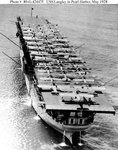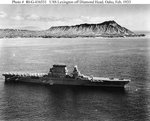trackend
Chief Master Sergeant
To begin this thread I thought it would help if we gave a brief back ground to the Carrier and how it evolved this is from a UK prospective
so I hope you guys will add you own information as I only know a limit amount
In the days of the muzzle loader navel battles where fought at almost point blank range with the opponents blasting away at each other with the advent of the breech loader these ranges increased dramatically until battles between big gun vessels could be at ranges of up to 18 or more miles. The problem was line of sight was the only way of laying the guns on target, the aircraft was seen by many as the answer as it could be used for scouting and then reporting the fall of shot.
Before the out break of WW1 experiments had taken place in the UK and USA at flying from warships indeed in the US a plane had even dropped a torpedo this was some what derided by the big gun brigade as they looked upon the aircraft as only any good for observation purposes.
Ships where converted both in the UK USA and France to carry sea planes, some short sight commanders thought the use of aircraft as an unsporting thing an army officer reportedly moaned of his maneuvers being "spoiled by the presents of planes".
In 1914 seven sea planes from the newly formed Royal Navy Air Service operating from the sea plane tenders (the first being HMS Hermes 1913 a reluctantly converted light cruiser) HMS Engadine,Express and Riviera attacked the airship hangers at Nordholz this proved that aircraft had more the just and observation role with the navy.
so I hope you guys will add you own information as I only know a limit amount
In the days of the muzzle loader navel battles where fought at almost point blank range with the opponents blasting away at each other with the advent of the breech loader these ranges increased dramatically until battles between big gun vessels could be at ranges of up to 18 or more miles. The problem was line of sight was the only way of laying the guns on target, the aircraft was seen by many as the answer as it could be used for scouting and then reporting the fall of shot.
Before the out break of WW1 experiments had taken place in the UK and USA at flying from warships indeed in the US a plane had even dropped a torpedo this was some what derided by the big gun brigade as they looked upon the aircraft as only any good for observation purposes.
Ships where converted both in the UK USA and France to carry sea planes, some short sight commanders thought the use of aircraft as an unsporting thing an army officer reportedly moaned of his maneuvers being "spoiled by the presents of planes".
In 1914 seven sea planes from the newly formed Royal Navy Air Service operating from the sea plane tenders (the first being HMS Hermes 1913 a reluctantly converted light cruiser) HMS Engadine,Express and Riviera attacked the airship hangers at Nordholz this proved that aircraft had more the just and observation role with the navy.



